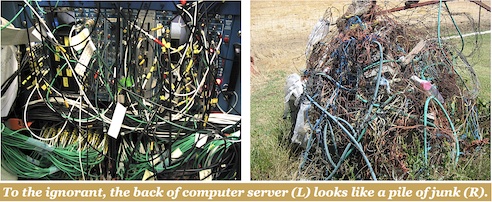Perhaps, for some of you, the following scenario won’t be too difficult to imagine. Consider the hapless husband who wanders into his basement, or his wife’s side of the closet, and declares that most of the stuff in there is junk, because he doesn’t see a purpose for it. All he sees are things that haven’t been used in a long time. Woe to the man who tries to haul any of it outside and throw it away, because when The Wife finds out, he will get more than an earful of purpose! Crazy as it may sound, that’s exactly what evolutionary scientists in the early 1970’s declared after sequencing part of the human genome. They found 90-98% of the genome didn’t seem to do anything useful (e.g., code for proteins), so they called it junk DNA.
Why would they jump to the conclusion that it’s junk? Because it fits their evolutionary worldview: this must be evidence of nature’s accumulation of blunders embedded in our makeup. Man is mostly made of proteins. 90-98% of DNA doesn’t code for proteins. Therefore, it must be junk. So simple. Or is it simply stupid?
This sounds a lot like the idea that humans had vestigial organs, such as tonsils or the appendix. Anytime they’d swell up, the doctors recommended their removal. (I still have mine, thank you mom!) We now know that your tonsils and appendix are release portals for your immune system, allowing a direct infusion of antibodies right where they are needed when fighting off disease. Sounds pretty important to me – like a well-placed fire hydrant. Almost seems designed. Unsurprisingly, the vestigial organ list continues to shrink.
Since the mid-90’s, research into the non-coding regions of DNA discovered some fascinating uses. Those regions create a broad number and type of RNA molecules which affect protein production in a variety of ways. The most recent find was documented in a Japanese research report in 2020. Geneticist Dr. Reina Komiya found a non-coding region to be essential for proper development of the male and female reproductive organs in rice. [1] Serving as a gene expression regulatory system, it interacts with other proteins to control organ growth and development, much like a foreman on a job site.
Damage to non-coding regions called introns leads to health disasters. When a few introns in the mouse genome were deleted, it induced disorders ranging from tremors to liver dysfunction.[2] Work in 2002 showed that if 4 letters in the center of an intron are deleted, it prevents proper splicing, resulting in mutations. Such mutations fail to suppress any bad parental genes, leading to severe diseases and cancer. Also, Dr. Jonathan Sarfati writes of “another intriguing discovery - that DNA can conduct electrical signals as far as 60 ‘letters,’ enough to code for 20 amino acids. The electrical signals could travel indefinitely, but single or multiple pairings [in non-coding regions] stop the signals; that is, they are insulators in a circuit. So, these particular regions protect essential genes from electrical damage from free radicals attacking a distant part of the DNA.” [3] Seems electrical insulation is a good idea.
As of 2012, the Encyclopedia of DNA Elements (ENCODE) confirms the vast majority of our genome is highly functional. ENCODE reveals non-coding DNA to be a huge control panel with millions of switches that turn protein-producing genes on or off. This should alter our approach to medicine since many illnesses are linked to mutations in non-coding DNA. [4]

Man’s ignorance is on display when he declares “no purpose” while looking at the master switchboard of the Creator, which doeth great things past finding out; yea, and wonders without number.
[1] Dr. Randy Guiluzza, ICR, Aug. 2020, Embarassment Continues Over Evolutionary Bonder About DNA Junk
[2] Jake Buehler, Quanta Magazine, Sep. 2021, The Complex Truth About Junk DNA
[3] Dr. Jonathan Sarfati, Creation Ministries International (CMI), Mar. 2003, DNA: Marvellous messages or mostly mess?
[4] Pekka Reinikainen, CMI, Junk DNA-From Science Stopper to Sickness Source.
Like this? Consider sharing it to Facebook by clicking the linked icon below.
